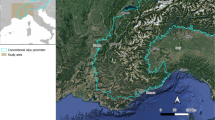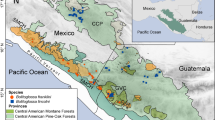Abstract
Modeling habitat connectivity for conservation of semi-aquatic vertebrates is a particularly challenging task, due to the fine-scale and linear distribution of riverine habitats and to the capacity of species to move both on freshwater and terrestrial realms. We showed how the integrated analytical framework provided by the habitat availability (reachability) metrics and their fractions can be used to effectively evaluate the distinctive roles and contributions of both habitat patches (aquatic and riparian) and linkage areas (permeable land matrix) to the connectivity and functioning of a complex system composed of multiple river catchments. Analysis focused on the Eurasian otter (Lutra lutra L.), one of the most endangered mammals in Italy. We developed a network connectivity model based on suitable otter habitats and multiple least-cost paths between catchments. A graph analytical approach was used to identify critical nodes and links for the potential expansion and long-term viability of the species in the region. Our results showed that few basins concentrate most of the importance for sustaining the overall habitat connectivity, due to the extension of suitable habitats they contain, their strong connections with other basins, and their importance as stepping stones that uphold ecological fluxes between otherwise weakly connected habitats. The potential contribution of each basin to enhance the dispersal and expansion of otters in the area strongly depended on the key functional paths (sequences of links and nodes) among the catchments. We identified vacant basins that could be colonized by otters in the near future, and connecting areas in the intermediate matrix that might be preferentially used to conduct and promote dispersal movements and gene flow in the area. The novel approach here adopted could be easily extended to other semiaquatic species and catchment systems, offering a management strategy to preserve the hydrographic network as an integrated system, as well as a joint evaluation of the role of both the river courses and the matrix in between in a single landscape model.



Similar content being viewed by others
References
Adriaensen F, Chardon JP, De Blust G, Swinnen E, Villalba S, Gulinck H, Mathyssen E (2003) The application of “least-cost” modelling as a functional landscape model. Land Urb Plan 64:233–247
Baranyi G, Saura S, Podani J, Jordan F (2011) Contribution of habitat patches to network connectivity: redundancy and uniqueness of topological indices. Ecol Indic 11:1301–1310
Beger M, Grantham HS, Pressey RL, Wilson KA, Peterson EL, Dorfman D, Mumby PJ, Lourival R, Brumbaugh DR, Possingham, HP (2010) Conservation planning for connectivity across marine freshwater and terrestrial realms. Biol Conserv 143:565–575
Bodin O, Saura S (2010) Ranking individual habitat patches as connectivity providers: integrating network analysis and patch removal experiments. Ecol Mod 221:2393–2405
Boitani L, Corsi F, Falcucci Maiorano L, Marzetti I, Masi M, Montemaggiori A, Ottavini D, Reggiani G, Rondinini C (2002) Rete Ecologica Nazionale. Un approccio alla conservazione dei vertebrati italiani. Italian Min Envir, Inst Appl Ecol Rome
Calabrese JM, Fagan WF (2004) A comparison-shopper’s guide to connectivity metrics. Front Ecol Environ 2:529–536
Cianfrani C, Le Lay G, Hirzel AH, Loy A, (2010) Do habitat suitability models reliably predict the recovery areas of threatened species? J Appl Ecol 47(2):421–430
Conroy JWH, Chanin P (2000) The status of the Eurasian otter (Lutra lutra) in Europe—a review. J Int Otter Surviv Fund 1:7–28
Cortés Y, Fernandez-Salvador R, Garcia FJ, Virgos E, Llorente M (1998) Changes in otter Lutra lutra distribution in central Spain in the 1964–1995 period. Biol Conserv 86(2):179–183
Cote D, Kehler DG, Bourne C, Wiersma YF (2009) A new measure of longitudinal connectivity for stream networks. Landscape Ecol 24:101–113
De Castro G, Loy A (2007) Un nuovo censimento della lontra (Lutra lutra Carnivora Mammalia) nel fiume Sangro (Abruzzo): inizia la ricolonizzazione dell’Italia centrale? UZI Congress: 105
Eros T, Schmera D, Schick RS (2010) Network thinking in riverscape conservation—A graph-based approach. Biol Conserv 144(1):184–192
Fusillo R, Marcelli M, Boitani L (2007) Survey of an otter Lutra lutra population in southern Italy: site occupancy and influence of sampling season on species detection. Acta Theriologica 52(3):251–260
Grant EHC, Lowe WH, Fagan WF (2007) Living in the branches: population dynamics and ecological processes in dendritic networks. Ecol Lett 10:165–175
Hilton-Taylor C (2000) Red list of threatened species. IUCN, Cambridge
Janssens X, Defourny P, de Kermabon J, Baret PV (2006) The recovery of otter in the Cevennes (France): a GIS-based model. Hystrix 17:5–14
Kruuk H (1995) Wild otters. Predation and populations. Oxford University Press, Oxford
Kruuk H (2006) Otters ecology behaviour and conservation. Oxford University Press, Oxford
Loy A, Bucci L, Carranza ML, De Castro G, Di Marzio P, Reggiani G (2004) Survey and habitat evaluation for a peripheral population of the Eurasian otter in Italy. IUCN Otter Spec Group Bull 21A:1–8
Loy A, Carranza ML, Cianfrani C, D’Alessandro E, Bonesi L, Di Marzio P, Minotti M, Reggiani G (2009) Otter Lutra lutra population expansion: assessing habitat suitability and connectivity in south-central Italy. Folia Zoologica 58(3):309–326
Loy A, Boitani L, Bonesi L, Canu A, Di Croce A, Fiorentino P L, Genovesi P, Mattei L, Panzacchi M, Prigioni C, Randi E, Reggiani G (2010) The Italian action plan for the endangered Eurasian otter Lutra lutra. Hystrix 21(1):19–33
Madsen AB, Prang A (2001) Habitat factors and the presence or absence of otters Lutra lutra in Denmark. Acta Theriologica 46:171–179
Marcelli M, Fusillo R (2009) Assessing range re-expansion and recolonization of human-impacted landscapes by threatened species: a case study of the otter (Lutra lutra) in Italy. Biodiv Conserv 18:2941–2959
Mason CF, Macdonald SM (1986) Otters. Ecology e conservation. Cambridge University Press, Cambridge
Ottaviani D, Panzacchi M, Jona Lasinio G, Genovesi P, Boitani L (2009) Modelling semi-aquatic vertebrates’ distribution at the drainage basin scale. The case of the otter Lutra lutra in Italy. Ecol Mod 220:111–121
Panzacchi M, Genovesi P, Loy A (2011) Piano d’azione nazionale per la conservazione della lontra (Lutra lutra). Quad Cons Natura, 35, Min Ambiente-ISPRA
Philcox CK, Grogan AL, Macdonald DW (1999) Patterns of otter Lutra lutra road mortality in Britain. J Appl Ecol 36:748–762
Prenda J, Granado CA (1996) The relative influence of riparian habitat structure and fish availability on otter Lutra lutra L.—sprainting activity in a small Mediterranean catchment. Biol Conserv 76(1):9–15
Prigioni C, Remonti L, Balestrieri A, Sgrosso S, Priore G, Mucci N, Randi E (2006a) Estimation of European otter (Lutra lutra) population size by fecal DNA typing in southern Italy. J Mamm 87:855–858
Prigioni C, Remonti L, Balestrieri A, Sgrosso S, Priore G (2006b) How many otters are there in Italy? Hystrix 17:29–36
Randi E, Davoli F, Pierpaoli M, Pertoldi C, Madsen AB, Loeschcke V (2003) Genetic structure in otter (Lutra lutra) populations in Europe: implications for conservation. Animal Conserv 6:93–100
Ray N (2005) PATHMATRIX: a geographical information system tool to compute effective distances among samples. Mol Ecol Notes 5:177–180
Rayfield B, Fortin MJ, Fall A (2010) The sensitivity of least-cost habitat graphs to relative cost surface values. Landscape Ecol 25:519–532
Ruiz-Olmo J, Saavedra D, Jimenez J (2001) Testing the surveys and visual and track censuses of Eurasian otters (Lutra lutra). J Zool 253:359–369
Ruiz-Olmo J, Loy A, Cianfrani C, Yoxon P, Yoxon G, de Silva PK, Roos A, Bisther M, Hajkova P, Zemanova B (2009) Lutra lutra. In IUCN 2009. IUCN Red List of Threatened Species. Available from http://www.iucnredlist.org
Saura S, Pascual-Hortal L (2007) A new availability index to integrate connectivity in landscape conservation planning: comparison with existing indices and application to a case study. Landsc Urb Plann 83:91–103
Saura S, Rubio L (2010) A common currency for the different ways in which patches and links can contribute to habitat availability and connectivity in the landscape. Ecography 33:523–537
Saura S, Torné J (2009) Conefor Sensinode 2.2: a software package for quantifying the importance of habitat patches for landscape connectivity. Env Mod Softw 24:135–139
Urban D, Keitt T (2001) Landscape connectivity: a graph-theoretic perspective. Ecol 82:1205–1218
Urban D, Minor ES, Treml EA, Schick RS (2009) Graph models of habitat mosaics. Ecol Lett 12:260–273
Vaisfeld MA (1996) The river otter in the European North of Russia. In: seminar on the conservation of the European otter (Lutra lutra). Council of Europe Publishing, Strasbourg, p 240
Ward JV, Tockner K (2001) Biodiversity: towards a unifying theme for river ecology. Freshw Biol 46:807–819
White PCL, McClean CJ, Woodroffe GL (2003) Factors affecting the success of an otter (Lutra lutra) reinforcement programme as identified by post-translocation monitoring. Biol Conserv 112(3):363–371
Wiens JA (2002) Riverine landscapes: taking landscape ecology into the water. Freshw Biol 47:501–515
Acknowledgments
The research was funded by the Italian Ministry of Environment (project ‘Rete Ecologica della Lontra—Fase 1′). Part of the research was developed during a PhD visiting period in the University of Lleida funded by the University of Molise. Support was also provided by the DECOFOR project (AGL2009-07140/FOR). We also thank the editor and two anonymous reviewers for helpful comments on the manuscript.
Author information
Authors and Affiliations
Corresponding author
Rights and permissions
About this article
Cite this article
Carranza, M.L., D’Alessandro, E., Saura, S. et al. Connectivity providers for semi-aquatic vertebrates: the case of the endangered otter in Italy. Landscape Ecol 27, 281–290 (2012). https://doi.org/10.1007/s10980-011-9682-3
Received:
Accepted:
Published:
Issue Date:
DOI: https://doi.org/10.1007/s10980-011-9682-3




